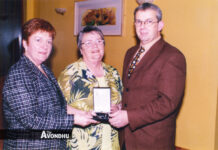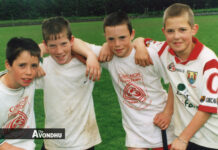
In the first of a two-part episode focusing on Cappoquin and its rich history, which aired on UTV Ireland last Sunday evening, Lesser Spotted Journeys looked at the effects of the plantation in the 17th century, the historically important Battle of Affane, the baking of the famous Blaa and the town’s continued association with road bowling.
Presented by Joe Mahon, Lesser Spotted Journeys’ second programme on Cappoquin will air on UTV Ireland next Sunday, November 13th at 5pm.
Filmed earlier in the year, the first programme began with a focus on the River Blackwater, which starts in Kerry, runs across Cork and into Waterford, taking a sharp right turn at Cappoquin before meeting the sea in Youghal, over 100 miles later.
“It’s also known as An Abha Mhór, meaning the big or the broad river, or as those of us privileged enough to travel any portion of its 105 mile journey – the great river. Not just because of its size or because it charts its own course through some of the lushest and loftiest banks in the country, but also because it has played a major role in determining the fortunes of the countless generations who have endeavoured to harvest its bounty and harness its power for thousands of years,” Mr Mahon said while boating on the river.
On the outskirts of Cappoquin, Joe meets local historian Kevin McCarthy in Affane to discuss the Battle of Affane between the Earl of Ormonde and the Earl of Desmond. The battle, regarded as the last private battle in Ireland, took place in 1565 and resulted in the death of a couple hundred men, with victory going to Thomas Butler, the 10th Earl of Ormonde.
According to Mr McCarthy, the battle resulted in a souring of the relationship between Queen Elisabeth I and the Desmonds. She confiscated their land and gave it to Sir Christopher Hatton. An influx of English settlers arrived in the area with Sir Walter Raleigh receiving 44,000 acres, though he later sold this land to Richard Boyle, the 1st Earl of Cork.
Around this time, smelting was carried out in Cappoquin and production began to grow, a wooden bridge was built (made from 600 tonnes of locally sourced oak and which stood for 200 years), with an ever greater influx of settlers from England.
As Joe explained: “The production of armaments and a range of other iron implements kick-started a precocious industrial revolution in these parts and soon, rooftops began to sprout amid the splendour of the Blackwater’s banks,” with the local population enjoying ‘modest prosperity in the period’.
Cappoquin, he said, was a ‘town of artisans and trades people, confident in a multitude of skills and manufacturing and engineering, and self sufficient within its own population for the provision of every material advantage befitting a thriving community’.
Despite this period of prosperity, Cappoquin suffered under the Great Famine and the stone bridge that replaced the wooden bridge was built on a famine relief scheme in the 1840s. The current population is less than a third of the pre-famine peak of around 3,000 people.
Joe then travelled to Barron’s Bakery to find out more about one of the county’s great claims to fame – the Blaa. Since 2013, the Blaa has been recognised with Protected Geographical Indication status by the European Commission, and it can only be produced in Waterford and parts of Kilkenny.
Blaa’s, a soft bap-like bread, is said to have been introduced to Waterford in the 17th century by the Huguenots of France, who found refuge in Ireland after King Louis XIV issued the Edict of Fontainebleau, ending legal recognition of Protestantism in the country.
Esther Barron has worked in Barron’s Bakery since she was a girl, and took over the running of the business from her father Joe in 1980. She spoke of the uniqueness of the Blaa to Waterford: “Dare you go 10 miles over the border to Cork and make a bap like that and call it a Blaa, you could be shot!”
Joe reached the half-way point of his Cappoquin tour with a look at road bowling, chatting with Tony Hickey about its roots in the area and across the country.









